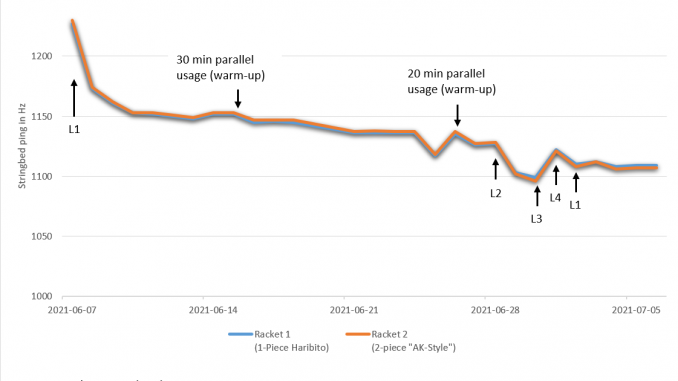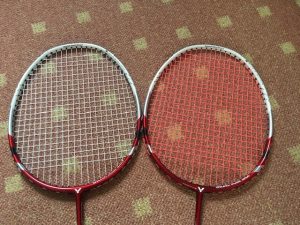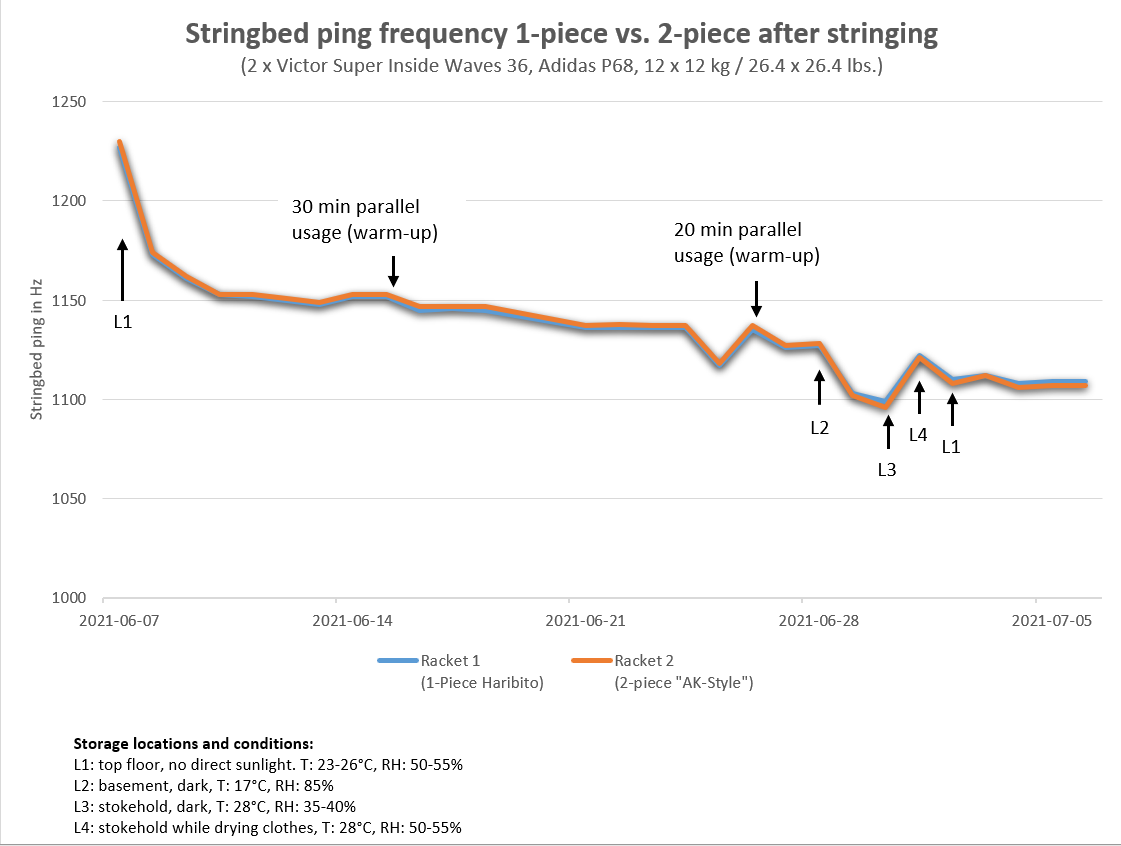
One topic that pops up on forums like BadmintonCentral on a regular basis is the question, if certain stringing patterns perform better or worse than others in terms of tension loss over time. A statement that comes up is that using 1-piece patterns have a bigger tension loss than 2-piece patterns (or vice versa), last seen in this thread: https://www.badmintoncentral.com/fo…-more-i-can-do-to-reduce-tension-loss.188003/
And so far, there has been a lot of opinions, impressions, myths and discussions, but very few to zero actual facts that might shed some light on the question. That’s the reason I’ve started my little experiement.
Experiment setup
Two identical rackets (Victor Super Inside Waves 36) were strung with the same string (Adidas Wucht P68, 0.68 mm gauge) directly back to back by the same stringer (myself) using the same machine (StringMaster Deluxe with WISE tension head), the same settings (12 x 12 kg / 26.4 x 26.4 lbs., no pre-stretch) and the same process flow details (no added tension before tie-off knots, no double pulls).
The only difference was the pattern used.
Racket #1 (white strings): 1-Piece Haribito Professional “Simon Mod”
Racket #2 (red strings): 2-Piece pattern “AK-style”.
So basically a standard Yonex pattern with Alan Kakinami’s special twist in terms of knot positions
The reason for using these two patterns was simple – those are the patterns that I am most comfortable with and hence have the lowest risk of making mistakes or delivering a weaker result due to the lack of experience with the used pattern. I’ve strung both rackets to the best of my abilities without any rush, so both jobs took about 30 minutes.

Measurements
Since I do not own any gear that can measure the actual dynamic tension of the stringbed (like this one for example: https://www.stringway-stringing-mac…-stringlab-2-stringbed-test-badminton-tennis/), I went with the frequently used measurement of the dominant stringbed resonance ping frequency, measured with the app CarlTune on an iPhone 12.
The measurements were done once every day for one month, the first one was done right after finishing the string job.
Both rackets have been stored right next to each other throughout the experiment and both rackets have been played simultaneously during warm-up and always “against each other” by players at the same playing level. Players have switched the rackets halfway through warm-up.
It’s of course possible that one of them has seem a couple of shots more or with a slightly different distribution of hitting power, but it should not be enough to make a real difference in the overall results.
The storage location of both rackets was changed several times during the second half of the experiment period. Reason was that I got a bit bored and wanted to see how much influence things like temperature and humidity changes might have on the ping readings. And let me spoiler already that this has produced some very interesting results that go beyond the original target of this experiment. More on this later on.
Side notes:
This is not a direct measurement of the string tension but it should still produce usable date for the comparison which is needed. I have done ping measurements for every string job over my first years as a stringer and I would say that I have gained serious experience in how to do this correctly (in case anyone needs more information on ping measurement, just click here: https://www.badmintoncentral.com/fo…d-frequency-to-monitor-string-tension.124011/).
It turned out that with the current version of CarlTune, it has become a lot more difficult to get a usable reading since the app has become a lot more sensitive and jumpy. However, I think that I was able to get usable results on all measurements. I would estimate that there is an inaccuracy of round about +- 2 Hz involved in every measurement. I did my best to middle out the readings by experience.
Results
Here are the graphs for both rackets. L1 to L4 show the moments when the rackets have been moved to the different storage locations and conditions (T: temperature, RH: relative humidity):

The original spreadsheet with all raw data can be found here:
https://www.dropbox.com/s/h71b3zlwcgm13wq/Tension Loss.xlsx?dl=0
Conclusion
Both pings have behaved pretty much identically, no matter the external influences.
There is no significant difference to be seen in terms of tension loss over time between 1-piece and 2-piece stringing patterns.
Looking at the data points, racket #1 had a slightly lower starting point (1127 Hz / 1130 Hz) and an ever so slight lead in the end (1109 Hz / 1107 Hz). Even if we ingored the fact that this is most likely within the range of measurement inaccuracy, those 5 Hz “loss” would translate to a difference of 0.17 lbs. if we follow the rule of thumb that 30 Hz difference equals 1 lb. in tension. So completely negligable.
Based on the data gathered in this one experiment, it doesn’t matter if a racket has been strung with a 1-piece or 2-piece pattern when it comes to the amount of tension loss afterwards. I don’t see any reason why results would be noticeably different with using other 1- or 2-piece patterns, as long as they have a comparable amount of slack string running around the outside of the frame.
There will surely be differences if we compare string jobs from different stringers and/or different machines, tension ratios, rackets or the strings used.
Join the discussion on BadmintonCentral:
https://www.badmintoncentral.com/forums/index.php?threads/tension-loss-experiments-1-piece-vs-2-piece-and-others.188234/